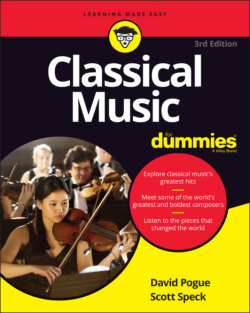Читать книгу Classical Music For Dummies - Scott Speck - Страница 5
List of Illustrations
Оглавление1 Chapter 2FIGURE 2-1: Giovanni da Palestrina, one of the greatest composers of the Renais...FIGURE 2-2: The florid Baroque style. FIGURE 2-3: George Frideric Handel, composer of Messiah and other great oratori...FIGURE 2-4: Johann Sebastian Bach, master of the organ. FIGURE 2-5: Joseph Haydn, a merry old soul. FIGURE 2-6: At left, Wolfgang Amadeus Mozart, boy wonder. At right, Mozart in h...FIGURE 2-7: Ludwig van Beethoven changed everything. FIGURE 2-8: Franz Schubert (1797–1828), one of the most prolific songwriters in...FIGURE 2-9: Felix Mendelssohn, the man who rediscovered Bach. FIGURE 2-10: Carl Maria von Weber, one of the earliest Romantic composers and a...FIGURE 2-11: Hector Berlioz: Romantic, visionary, compositional genius, loony t...FIGURE 2-12: Frédéric Chopin revolutionized the sound of the piano. FIGURE 2-13: Robert Schumann, one of the foremost German Romantic composers. FIGURE 2-14: Johannes Brahms, one of the greatest of all composers of classical...FIGURE 2-15: Niccolò Paganini (left) and Franz Liszt, classical music’s first s...FIGURE 2-16: Richard Wagner, the height of German Romantic music. FIGURE 2-17: Richard Strauss (left) and Gustav Mahler, two of the most ardent d...FIGURE 2-18: Antonín Dvořák. FIGURE 2-19: The Norwegian Edvard Grieg (left) was one of the most well-known n...FIGURE 2-20: Peter Ilyich Tchaikovsky, the best of the Russian Romantic compose...FIGURE 2-21: Sergei Rachmaninoff, the Russian piano master. FIGURE 2-22: Claude Debussy was one of the brightest lights on the Impression-i...FIGURE 2-23: Igor Stravinsky, the most important composer of the 20th century. FIGURE 2-24: Aaron Copland (left) and George Gershwin, two of America’s most be...
2 Chapter 4FIGURE 4-1: A metronome helps composers mark time. FIGURE 4-2: A conductor’s beat pattern indicates the different beats of the mus...
3 Chapter 6FIGURE 6-1: The notes of the piano keyboard. FIGURE 6-2: A grand piano (top) and an upright piano (bottom). FIGURE 6-3: A harpsichord with a double keyboard. FIGURE 6-4: A pipe organ.
4 Chapter 7FIGURE 7-1: A violin with a bow. FIGURE 7-2: The cello, the string instrument that sounds most like the human vo...FIGURE 7-3: The double bass, granddaddy of the string section, plays the lowest...FIGURE 7-4: The harp, all 47 strings of it. FIGURE 7-5: A guitar’s fingerboard has frets.
5 Chapter 8FIGURE 8-1: The flute. FIGURE 8-2: Still life: Oboe, with reed. FIGURE 8-3: A clarinet. FIGURE 8-4: The saxophone. FIGURE 8-5: The bassoon.
6 Chapter 9FIGURE 9-1: The modern French horn. FIGURE 9-2: The trumpet. FIGURE 9-3: The trombone. FIGURE 9-4: The tuba.
7 Chapter 10FIGURE 10-1: A timpani. FIGURE 10-2: The Glockenspiel and the triangle. FIGURE 10-3: Hey, Mr. Tambourine Man — here’s your instrument!
8 Chapter 11FIGURE 11-1: A musical timeline, otherwise known as the musical staff, with bar...FIGURE 11-2: Four beats to the measure. FIGURE 11-3: Different notation, same meaning. FIGURE 11-4: Twinkle, twinkle! FIGURE 11-5: Name that tune! FIGURE 11-6: The albino half note. FIGURE 11-7: The whole note. FIGURE 11-8: The joining of the eighths. FIGURE 11-9: Sweet sixteenths. FIGURE 11-10: Your rhythmic reading final exam. FIGURE 11-11: An octave of notes, from A to shining A. FIGURE 11-12: The glorious G clef! FIGURE 11-13: Where the other notes of the alphabet go. FIGURE 11-14: Presenting the amazing colossal infinite staff! FIGURE 11-15: A feat of legerdemain: ledger lines. FIGURE 11-16: The bass clef, featuring the Klingon F. FIGURE 11-17: The treble and bass clefs: together at last. FIGURE 11-18: An example of some piano music. FIGURE 11-19: Sharps and flats. FIGURE 11-20: Maybe reading music isn’t as difficult as nuclear physics after a...FIGURE 11-21: Count the F-sharps. FIGURE 11-22: A key signature. FIGURE 11-23: Examples of three different key signatures. FIGURE 11-24: You can play “Joy to the World” by starting on C and playing each...FIGURE 11-25: ”Joy to the World” again — but this time in the key of D. FIGURE 11-26: Can you determine the keys of these pieces from their last notes?...FIGURE 11-27: The major second interval in one of your favorite Christmas songs...FIGURE 11-28: Dance all night to this interval, baby! FIGURE 11-29: Here comes the fourth! FIGURE 11-30: Pick up a fifth of musical pleasure with this interval. FIGURE 11-31: Try getting a sixth sense of this interval. FIGURE 11-32: In Oz, the octave reigns. FIGURE 11-33: The minor second. FIGURE 11-34: No matter what color your sleeves, you should be able to hear the...FIGURE 11-35: Beware the devil’s interval — the unholy tritone! FIGURE 11-36: Love that minor sixth interval! FIGURE 11-37: There’s an interval for us — the minor seventh. FIGURE 11-38: A major scale can start anywhere, even on a D, if you skip over k...FIGURE 11-39: It’s Brahms! FIGURE 11-40: The two-dimensional shape of music: melody and harmony. FIGURE 11-41: The C major chord (left) and the C minor chord (right). FIGURE 11-42: Starting at C, you can denote the different keys by using Roman n...FIGURE 11-43: These three songs all use the three notes of the C chord for thei...FIGURE 11-44: Passing tones aplenty.
9 Chapter 12FIGURE 12-1: A sheet of score paper, showing which instruments play what.
